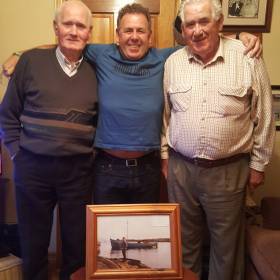Displaying items by tag: Bravery
Relatives Express Delight at Award for Donegal Fishermen, 63 years After Rescue of 18 people
The relatives of a Fermanagh woman who was one of 18 people rescued by two Donegal fishermen have expressed delight that the men are to receive national bravery awards – all of 63 years after the event writes Lorna Siggins
James and Michael “Mickey Red” Gallagher, aged 85 and 80 respectively, will be conferred with State bravery awards today at Farmleigh House, Dublin, and their late father, Michael, will be given posthumous recognition for his role.
The late Jean Morrell, née Mavitty, from Enniskillen, Co Fermanagh, was one of the 18 saved by the Gallagher brothers, after the punt she was a passenger in sank off Roaninish skerries, some five km off Portnoo, Co Donegal.
Jean Mavitty was aged 15 at the time, and had to be restrained by the Gallaghers from trying to jump in again to save her dad after she had been pulled from the Atlantic.
The body of her father, Desmond Mavitty (49), was found three weeks later on Roaninish. He was one of three fatalities.
A young boy, Christopher Chambers, was fatally injured in the propeller of a nearby yacht which had tried to help, while a family friend of the Mavittys, George Warren (55), was taken from the water by the fishermen. In spite of attempts to resuscitate him, he did not survive.
The fishermen, who had set out from Rutland island to fish for lobsters in their father’s half decker, Irine, took the 15 rescued from the water after the punt sinking back into Portnoo.
They also secured the body of Christopher Chambers, and towed in the yacht with three people on board to safety.
There were no VHF radios at the time to contact the RNLI Arranmore lifeboat, and limited communication meant that there were no Gardai at the pier. The fishermen were not notified of the inquest into the three fatalities, which took place that night.
When they got home to Rutland island, which lies between Burtonport and Arranmore, they remember their mother was beside herself with worry, as she had by then heard a report of a sinking and thought her husband and sons had been lost.
Jean Mavitty’s son, Robert, lives in Enniskillen, and said his late mother often talked about the incident, but did not know who to thank. He said she made sure to teach her two children to swim in the sea when they returned on holidays to Portnoo.
“All she remembered at that time was seeing a boathook - none of them had lifejackets when they were pulled out,”Mr Morrell said.
“ My mum had passed her lifesaving awards just a couple of months before, and that was what really upset her about losing her father,,”Mr Morrell said.
Mr Morrell is due to travel to Dublin today (fri) with his sister, Jenny, to congratulate the Gallaghers.
The siblings only learned about the Gallaghers’ involvement two months ago, and visited them recently at their home in Burtonport.
“Together , we feel sure that mum would be proud to acknowledge her personal heroes,” they said. “Without those men, we would not be here...”
The Gallaghers are among 19 recipients of State awards for 12 instances of bravery, and one posthumous award will be conferred on their father, Michael.
The honours will be awarded at Farmleigh House, Dublin, today (oct 18) by Comhairle na Míre Gaile – the Deeds of Bravery Council.
It was established in 1947 to “provide for suitable recognition by the State of deeds of bravery”, and is chaired by the Ceann Comhairle of the Dáil.
Eight serving and one retired Garda are also recipients this year, and the full list is as follows:
Adrian Brennan, Kilkenny; retired Garda Desmond Brennan, Dublin; Garda Pauric Deery, Sligo.; Basil Harte , Sligo; James Hennessy, Cork; Olive Murphy, Cork; Aonghus O’Briain, Dublin; Michael Hempenstall, Dublin; Garda Donal Tully, Dublin; Garda David Currivan, Dublin; Garda Cathal McGeoghan, Dublin; James Gallagher (Snr), Donegal; Mickey ‘Red Michael’ Gallagher , Donegal; Michael Gallagher (Snr),Donegal (posthumous award); Garda Seán Breheny, Dublin; Gary Kennedy, Mayo; Garda Darren Blackwell, Dublin; Sergeant Gavin Coleman, Dublin; Garda M.J. Carroll, Dublin; Garda Jason Walsh, Dublin.






























































